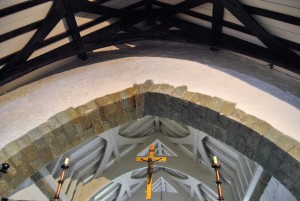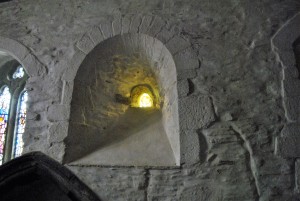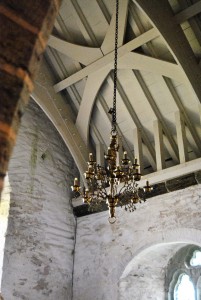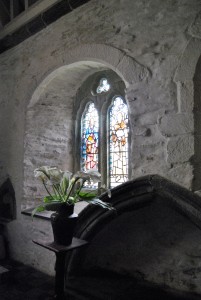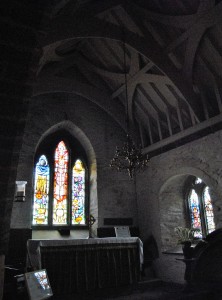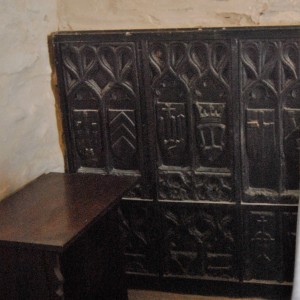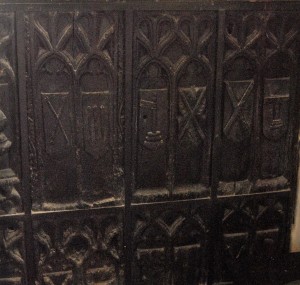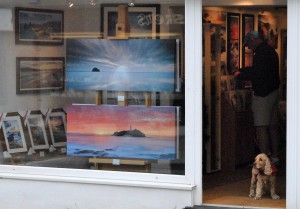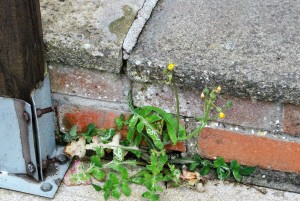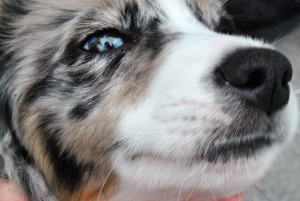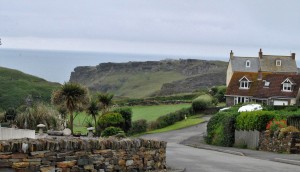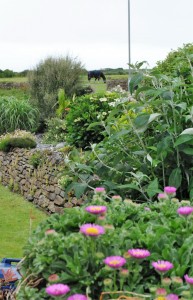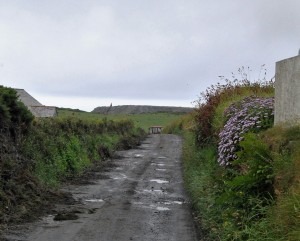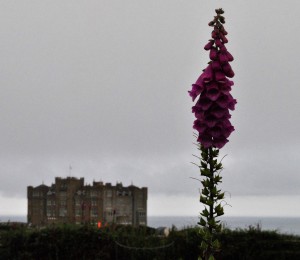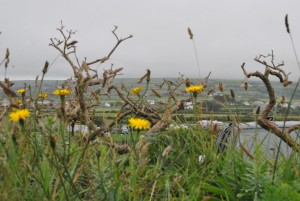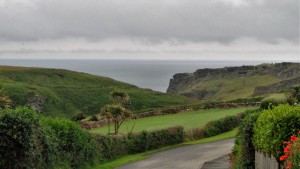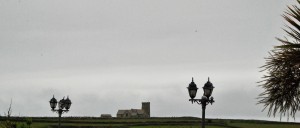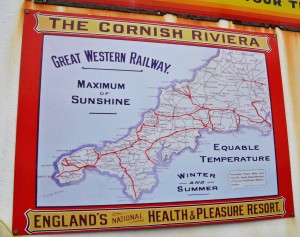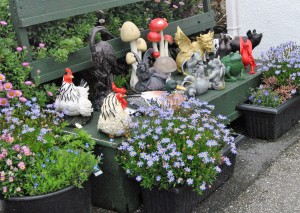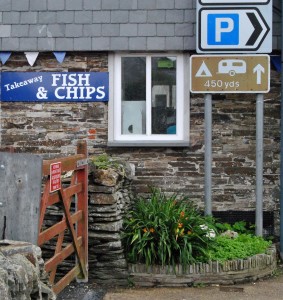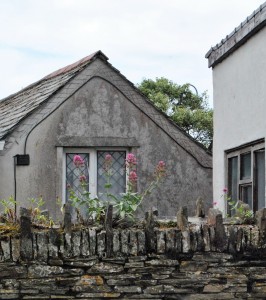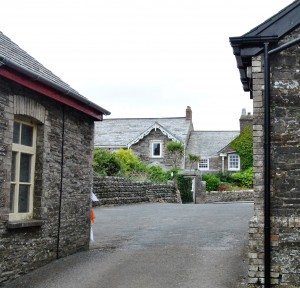First I’ll start today with some more up close and personal look at the Tintagel church and then we just give you some pictures on and off the beaten path in the same village.
The weather has been dark and occasionally rainy—-but none of the horrid down pours that they’re seeing all over Britain, so I guess I can’t complain….well of course I can but….
First My favorite Church continued—Tintagel’s oldie and greatie:
THE CHANCEL
The Rood Screen:
Probable date of 1599 with the main structure intact. The canopy was either destroyed when the Rood was torn down at the Reformation, or was allowed to collapse. Dark stains covers the original painting. There are indications that the steps to the Rood loft were in the angle of the all on the south side.
The figure of Our Lord on the Rood now hanging above the screen was carved by Peter Rendl who represented St. John in thee Oberammergau Passion Play of 1910.
The Canopied Recess:
on the south side of the chancel has always been known as the Founder’s Tomb, but as it is of 14th century t, it certainly cannot be the tomb of the original founder. The term
“founder” was apparently used rather loosely in the Middle Ages to denote any wealthy benefactor.
In order to make way for this recess, one of the two original Norman window on the south was blocked up except for a small rounded portion at the top. A priest’s doorway seems also to have been blocked up earlier still, to admit the window (see the rounded top markings in this picture–what you can’t see in this picture but that’s also here is an indication that there was a step here.
The Candelabrum: Reportedly originally from a church in Belgium, was a gift many years ago from a Roman Catholic, who was an admirer of Tintagel Church.
The Window: South side of altar is in memory of Revd. A.B. Blissard-Barnes (Vicar 1920 – 1938) shows St Piran and St. Julitta, patrons of the chapels of Trethevy and the Castle.
The East Window: Modern stained glass East Window was designed and executed by Mr. Alfred Fisher of Hunton Bridge, Hertfordshire
The main theme is the Eucharist. In the Center if the risen Christ shown as celebrant in Mass vestments, above Him is a dove, symbolizing the Holy Spirit and below a device representing the Holy Trinity. On the left and right of the Christ are wheat and grapes, representing the brad and wine. Below these are wild flowers (left) and children (right), both among Fr. Cranner’s (who the window is dedicated to) chief interests. At the top two side lights are the moon, stars and the sun.
The Renedos: Made up of part of old bench ends (from this church as well as St. Teath) which date from the 15th century. The carvings show the emblems of the Passion spar an sponge nails, whipping post and scourges as well as sacred monograms and also include coats of arms of the ancient and illustrious family of the Archdenknes, who were lords of the manner of Trebanwith. Other pieces may b from the lost canopy of the rood-screen or the roof.
More of the church on 24th.
and now a return to my wandering in Tintagel.
Set high on the rugged North Cornwall coast, Tintagel has dramatic sea views both from the castle ruins on the headland and island.
Sample some of Granny Wobbly’s fudge at her shop on the main street. Choose from vanilla, maple and walnut, rum and raisin, butterscotch and chocolate, all traditionally made on the premises. https://www.visitcornwall.com/places/tintagel
I BUY the cookies and share them with the staff here….I get one with my hot tea at bedtime. Gonna miss those in the ole USA.
Art lover dog
my dog of the day—but I’m sure there will be more
In Cornwall (and thus Tintagel) flowers–large or in this case small grows anywhere or everywhere.
Tintagel /tɪnˈtædʒəl/ or Trevena (Cornish: Tre war Venydh[ meaning village on a mountain)
Ole Blue Eyes
The village and nearby Tintagel Castle are associated with the legends surrounding King Arthur and the knights of the Round Table.
How can you not enjoy a walk in this grand scenery?
The village has, in recent times, become attractive to day-trippers and tourists, and is one of the most-visited places in Britain.
The wall above is a fine example of the Cornish Mortor-less walls…yep they’re just stacked that way–nothing to hold them together. Cool
The modern-day village of Tintagel was always known as Trevena (Cornish: Tre war Venydh) until the Post Office started using ‘Tintagel’ as the name in the mid-19th century (until then Tintagel had been restricted to the name of the headland and of the parish).
and the countryside is just across a fence line
In Geoffrey of Monmouth‘s Historia Regum Britanniae (c. 1136), Gorlois, Duke of Cornwall, puts his wife Igraine in Tintagol while he’s at war …Tintagel is also used as a locus for the Arthurian mythos by the poet Alfred, Lord Tennyson in the poem Idylls of the King….Algernon Charles Swinburne‘s Tristram of Lyonesse is a literary version of the Tristan and Iseult legend in which some events are set at Tintagel. Thomas Hardy‘s The Famous Tragedy of the Queen of Cornwall at Tintagel in Lyonnesse, a one-act play which was published in 1923, is another version of the same legend with events set at Tintagel
And some day I hope to add my novel to a long line of books set in Tintagel…who knows I’m at least back to writing again. https://en.wikipedia.org/wiki/Tintagel
Some views:
given the number of four legged companions out and about with the British visitors — the rules
for non-Brit pets are major so most of these short term vacationers usually leave the pets where ever they came from–but the Brits have so many that they’re everywhere and allowed in a large number of stores, cafes, etc in this village.
The turquoise green water around this coast is caused by the slate/sand around Tintagel which contains elements of copper: strong sunlight turns the water a light turquoise green colour in warm weather. The rocks contain various metal ores in small amounts: a few of these were mined in the Victorian period.[ https://en.wikipedia.org/wiki/Tintagel
OK so that’s more of the town that I have called home for a few weeks—back to London next week and home a day later.


